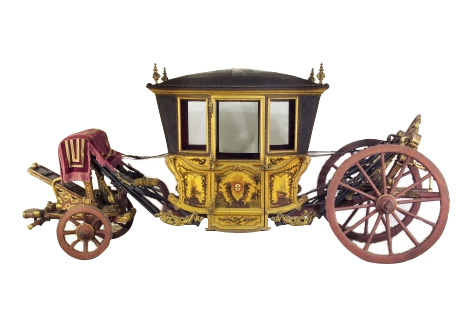Carriages
The Carriage Museum is spread across four buildings in the ‘Terreiro da Ilha’ area to the north of the Ducal Palace in Vila Viçosa.
The Royal Coach House was built in the reign of King João V in 1728 to replace the 17th-century coach house commissioned by the seventh Duke of Bragança, Teodósio II. It was built to meet the need to accommodate a large number of royal carriages, which came for the ceremony known as the ‘Exchange of Princesses’ on the border, overlooking the River Caia. The two Iberian royal families reinforced their ties through the marriage of Bárbara of Portugal (daughter of King João V and Archduchess Maria Anna of Austria) to the heir to the Spanish crown, Fernando VI of Spain, and of Princess Mariana Victoria of Spain (daughter of King Felipe V and Elisabetta Farnese) to the future King José I of Portugal.
The Dom José Royal Stables were built in 1752. They are about 70 metres long by 7.5 metres wide, and were thus able to house dozens of horses.
The double stables were built in the reign of Queen Maria I of Portugal. Each of the buildings is about 70 metres long. The interior, which is laid out in three naves, still features the original mangers along the side walls. The roof of the second building is a slatted, unlined tiled roof in the traditional Alentejo style.

This space is home to carriages from the National Coach Museum, the Palace of Ajuda, the Machado de Castro National Museum, Lisbon City Hall and the Library-Museum of the House of Bragança, together with various private long-term loans.
This highly diverse collection includes models ranging from ceremonial carriages from the early 18th century to light hunting vehicles from the early 20th century. They were brought together here in order to allow visitors to discover how horse-pulled transport evolved over time.
Photo: Direção-Geral do Património Cultural / Arquivo de Documentação Fotográfica (DGPC/ADF)
ROYAL STABLES OF KING JOSÉ I / INV. PNA 50864 / [Roteiro MNC – 22]
It belonged to the Patriarchal Palace of São Vicente de Fora, Lisbon.
Photo: Direção-Geral do Património Cultural / Arquivo de Documentação Fotográfica (DGPC/ADF)
ROYAL STABLES / INV. MNC 18 / [Roteiro MNC – 1]
It belonged to the Archbishops of Évora.
Photo; Fundação da Casa de Bragança (FCB)
ROYAL STABLES / INV. 3358 MUSEU DE ÉVORA / [Roteiro MNC – 3]
This forms part of a set of berlins commissioned by King João V in Paris in 1727.
PHoto: Direção-Geral do Património Cultural / Arquivo de Documentação Fotográfica (DGPC/ADF)
ROYAL STABLES / INV. MNC 32 / [Roteiro MNC – 5]
This is another of the three vehicles brought to Portugal by Princess Carlota Joaquina de Bourbon, the daughter of Carlos IV of Spain, on the occasion of her marriage to the future King João VI.
Photo: Direção-Geral do Património Cultural / Arquivo de Documentação Fotográfica (DGPC/ADF)
ROYAL STABLES OF KING JOSÉ I / INV. MNC 25 / [Roteiro MNC – 7]
In the Louis XV style, it has a box with a light green background, gilded borders with plant motifs and gilded woodcarving. Its handles, nailwork and buckles are made of chased bronze, while the curtains are of green silk. It is accessed via a hanging stirrup. A special support system for the box is deployed in the rear undercarriage.
Photo: Direção-Geral do Património Cultural / Arquivo de Documentação Fotográfica (DGPC/ADF)
ROYAL STABLES OF KING JOSÉ I / INV. MNC 31 / [Roteiro MNC – 10]
In the 19th century, the shield of the then-Patriarch, Dom Frei Patrício da Silva, was added.
Photo: Direção-Geral do Património Cultural / Arquivo de Documentação Fotográfica (DGPC/ADF)
ROYAL STABLES OF KING JOSÉ I / INV. MNC 37 / [Roteiro MNC – 12]
It belonged to the Viscount of Esperança.
Photo: Direção-Geral do Património Cultural / Arquivo de Documentação Fotográfica (DGPC/ADF)
ROYAL STAB. OF KING JOSÉ I / INV. No. 3359 MUSEU DE ÉVORA / [Roteiro MNC – 13]
Chaises became particularly popular and were used as rental vehicles.
Photo: Direção-Geral do Património Cultural / Arquivo de Documentação Fotográfica (DGPC/ADF)
ROYAL STABLES OF KING JOSÉ I / INV. MNC 49 / [Roteiro MNC – 14]
Used by the royal family at their Queluz, Mafra and Lisbon estates.
Photo: Direção-Geral do Património Cultural / Arquivo de Documentação Fotográfica (DGPC/ADF)
ROYAL STABLES OF KING JOSÉ I / INV. MNC 51 / [Roteiro MNC – 15]
It belonged to Coimbra Episcopal Palace.
Photo: Direção-Geral do Património Cultural / Arquivo de Documentação Fotográfica (DGPC/ADF)
ROYAL STABLES OF KING JOSÉ I / INV. MNC 7350 / [Roteiro MNC – 75]
Photo: Direção-Geral do Património Cultural / Arquivo de Documentação Fotográfica (DGPC/ADF)
ROYAL STABLES OF KING JOSÉ I / INV. PNA 50861 / [Roteiro MNC – 69]
Photo: Direção-Geral do Património Cultural / Arquivo de Documentação Fotográfica (DGPC/ADF)
ROYAL STABLES OF KING JOSÉ I / INV. PNA 50868 / [Roteiro MNC – 19]
Photo: Direção-Geral do Património Cultural / Arquivo de Documentação Fotográfica (DGPC/ADF)
ROYAL STABLES OF KING JOSÉ I / INV. PNA 50862 / [Roteiro MNC – 21]
Photo: Direção-Geral do Património Cultural / Arquivo de Documentação Fotográfica (DGPC/ADF)
ROYAL STABLES OF KING JOSÉ I / INV. PNA 50867 / [Roteiro MNC – 60]
Made for Queen Maria II. It bears the painted monogram of King Carlos, the last monarch to use this vehicle.
Photo: Direção-Geral do Património Cultural / Arquivo de Documentação Fotográfica (DGPC/ADF)
ROYAL STABLES OF KING JOSÉ I / INV PDVV / [Roteiro MNC – 24]
Acquired in Paris by the 6th Duke of Cadaval, it now belongs to the Countess of Schonborn.
Photo: Direção-Geral do Património Cultural / Arquivo de Documentação Fotográfica (DGPC/ADF)
STAB. OF QUEEN MARIA I(Pavilion I) / SCHONBERG COLL., on loan / [Roteiro MNC – 59]
Photo: Direção-Geral do Património Cultural / Arquivo de Documentação Fotográfica (DGPC/ADF)
STABLES OF QUEEN MARIA I (Pavillion I) / INV. PDVV / [Roteiro MNC – 61]
It belonged to the Count of Boavista and later to the Viscount of Corte.
Photo: Direção-Geral do Património Cultural / Arquivo de Documentação Fotográfica (DGPC/ADF)
STABLES OF QUEEN MARIA I (Pavillion I) / INV. MNC 87 / [Roteiro MNC – 54]
It belonged to the 1st Marquis of Valada.
Photo: Direção-Geral do Património Cultural / Arquivo de Documentação Fotográfica (DGPC/ADF)
STABLES OF QUEEN MARIA I (Pavillion I) / INV. PNA 54370 / [Roteiro MNC – 57]
Photo: Direção-Geral do Património Cultural / Arquivo de Documentação Fotográfica (DGPC/ADF)
STABLES OF QUEEN MARIA I (Pavillion I) / INV. MNC 86 / [Roteiro MNC – 70]
The name ‘phaeton’ comes from Greek mythology, in which Phaeton drives the chariot of the sun.
Photo: Direção-Geral do Património Cultural / Arquivo de Documentação Fotográfica (DGPC/ADF)
STABLES OF QUEEN MARIA I (Pavillion I) / INV. MNC 95 / [Roteiro MNC – 28]
[On loan from Fernando de Sousa]
Photo: Direção-Geral do Património Cultural / Arquivo de Documentação Fotográfica (DGPC/ADF)
STABLES OF QUEEN MARIA I (Pavillion II) / INV. MNC 114 / [Roteiro MNC – 26]
It belonged to the Count of São Martinho.
Photo: Direção-Geral do Património Cultural / Arquivo de Documentação Fotográfica (DGPC/ADF)
CAVALARIÇA D. MARIA I (Pavilhão II) / INV. MNC 110 / [Roteiro MNC – 34]
It belonged to the Count of São Martinho.
Photo: Direção-Geral do Património Cultural / Arquivo de Documentação Fotográfica (DGPC/ADF)
STABLES OF QUEEN MARIA I (Pavillion II) / INV. MNC 108 / [Roteiro MNC – 32]
It belonged to the Count of São Martinho.
Photo: Direção-Geral do Património Cultural / Arquivo de Documentação Fotográfica (DGPC/ADF)
STABLES OF QUEEN MARIA I (Pavillion II) / INV. MNC 88 / [Roteiro MNC – 42]
It belonged to Coimbra Episcopal Palace.
Photo: Direção-Geral do Património Cultural / Arquivo de Documentação Fotográfica (DGPC/ADF)
STABLES OF QUEEN MARIA I (Pavillion II) / INV. MNMC 7345 / [Roteiro MNC – 55]
Photo: Direção-Geral do Património Cultural / Arquivo de Documentação Fotográfica (DGPC/ADF)
STABLES OF QUEEN MARIA I (Pavillion II) / INV. PNA 50947 / [Roteiro MNC – 66

Quick Links
Head Office
Casa de Massarelos, Estrada da Gibalta
2760-064, Caxias
Paço Ducal
Newsletter
Fundação da Casa de Bragança © 2020
Privacy Policy | Cookies Policy



